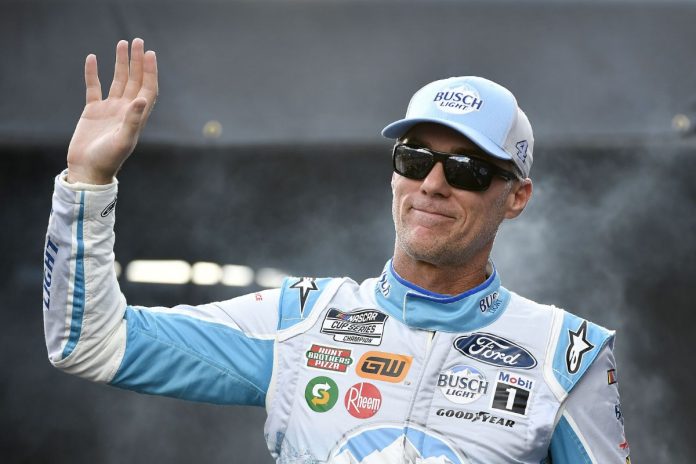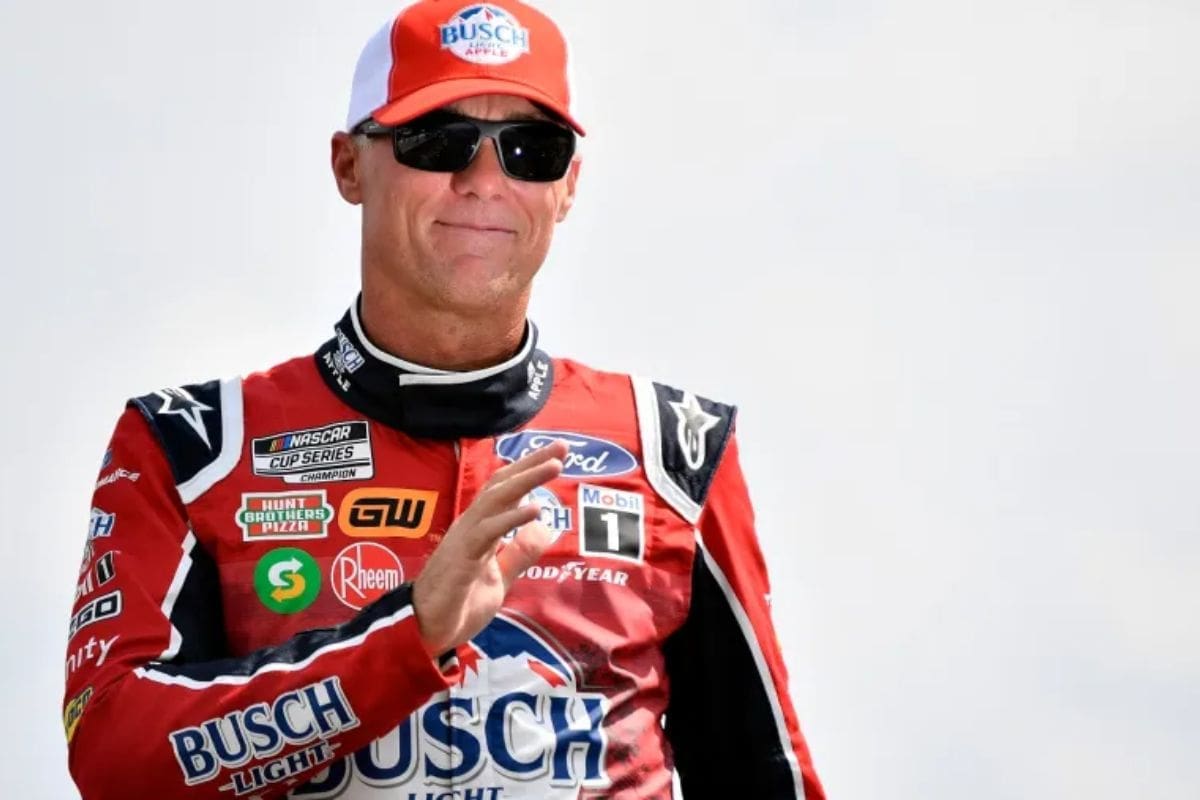Kevin Harvick’s Rant On Pylon: Kevin Harvick’s strong criticism of NASCAR’s decision to remove pylons has not only inflamed passions but also highlighted a deeper rift between race tradition and modernization efforts. His argument that pylons are vital for driver orientation, strategic racing, and fan engagement reiterates their multifaceted role within the sport. As NASCAR seeks to balance innovation with its rich heritage, Harvick’s outburst brings to the forefront important questions about the evolution of racing environments and the potential repercussions on the sport’s core aspects.
Key Takeaways
- Kevin Harvick criticizes NASCAR’s decision to remove pylons from superspeedways, emphasizing their historical and strategic importance.
- Harvick argues that pylons are crucial for enhancing fan engagement and improving the race-watching experience.
- The removal is part of a cost-cutting initiative by NASCAR, which Harvick and fans are concerned could negatively impact the sport.
- Pylons serve as critical reference points for drivers, aiding in navigation and safety during races.
- Fans and Harvick advocate for the reinstatement of pylons, highlighting their role in the overall spectacle and integrity of NASCAR events.
NASCAR Controversy: Pylons Removed from Talladega and Superspeedways
The recent decision by NASCAR to eliminate pylons from Talladega’s tri-oval track and other superspeedways has sparked significant controversy among drivers and fans, driven by underlying economic motivations. The pylons, integral to the organization of these high-speed tracks, were reportedly removed to reduce operational costs and streamline race logistics. This strategic shift, while financially prudent from NASCAR’s perspective, has introduced a series of unintended consequences that have spread across the sport.
The removal of these pylons has fundamentally altered the racing dynamics at superspeedways. Traditionally, pylons serve as critical markers that guide drivers during the NASCAR races. They play an important role in ensuring safety and competitive fairness, providing visual cues that help drivers gauge their positions relative to the track boundaries and other vehicles. Without these markers, drivers are left to rely more heavily on spotters and their own split-second judgment, which increases the risk of miscalculations and accidents.
Economically, the decision was influenced by a broader cost-cutting initiative within NASCAR, aimed at maintaining financial sustainability amid fluctuating sponsorship revenues and viewership numbers. By reducing the physical infrastructure required at each event, NASCAR hopes to allocate resources more effectively and improve the profitability of its operations.
Kevin Harvick Voices Discontent
Frequently outspoken, Kevin Harvick recently expressed his strong disapproval of NASCAR’s decision to remove pylons, emphasizing their significance in enhancing the complete race experience for fans. During his podcast, ‘Kevin Harvick’s Happy Hour,’ Harvick articulated a scathing critique of the policy change, which he believes could diminish the sport’s appeal and possibly affect its integrity.
“’Hey go to the app, don’t watch the race. Go to the app and see what lap we’re on.’ That makes no sense! How about we put a pylon up so everybody could see what position your car is running in a scoreboard.”
“What drunk race fans do you think are going to look at their phone? You don’t wanna hold a beer and a phone.” -Harvick
- Historical Significance: Harvick noted that pylons have been a traditional component at NASCAR races, serving not just as physical markers but also as symbols of the sport’s rich legacy and competitive spirit. Their presence at the track contributes to the nostalgic value that many fans cherish.
- Fan Engagement: The pylons, according to Harvick, play an important role in enhancing fan engagement. They add a visual element to the spectator experience, making the race more understandable and exciting for fans in the stands and those watching from home.
- Driver Strategy: From a competitor’s perspective, pylons are essential in planning race strategy. They serve as key reference points on the track, aiding drivers in making split-second decisions that can affect the outcome of the race.
- Safety Considerations: Contrary to the reasoning behind their removal, Harvick argues that pylons contribute to safety. They provide clear demarcations that help manage the flow of cars, particularly in congested areas, thereby potentially reducing the risk of accidents.
Fans and Kevin Harvick Disapprove
An unofficial survey from the camping grounds—a vibrant hub for the sport’s most ardent followers—highlighted a strong preference for the traditional use of pylons. The fans argue that these structures not only serve as physical landmarks but also greatly assist in tracking the progression of the race more effectively from their vantage points.
“I don’t care. I wanna see the pylon back up in the in-field. When it blows down, put it back up. Ensure that, baby, something…Everybody likes to look at the pylon.”-Harvick
This collective disapproval from fans and a prominent figure like Harvick poses a significant question about the balance between technological advancement and spectator satisfaction in sports. It emphasizes the need for governing bodies to take fan-based feedback into account in their operational changes, ensuring that the essence of the live sports experience remains intact and vibrant.
Pylons: More Than Just for Fans
While fans and racers like Kevin Harvick have highlighted the spectator benefits of pylons, their importance extends to professionals working behind the scenes, particularly photographers who rely on these markers to capture dynamic race images effectively. Pylons serve as significant reference points on the racetrack, enabling photographers to anticipate where action might occur and position themselves accordingly. This strategic positioning is pivotal for capturing high-quality images that convey the speed and intensity of NASCAR races.
- Localization: Pylons help photographers pinpoint exact locations on the track, crucial for planning shot compositions and focusing on specific race segments.
- Timing: By understanding the spacing between pylons, photographers can better time their shots to capture vehicles as they zoom past at high speeds, ensuring clarity and sharpness in their photographs.
- Safety: Pylons also contribute to safety by marking track boundaries clearly, allowing photographers to maintain a safe distance from the high-speed action while still capturing engaging images.
Kevin Harvick’s Justified Outburst
Kevin Harvick’s outspoken criticism of NASCAR’s decision to eliminate pylons from racing circuits highlights a broader debate about their important role in improving race dynamics and safety. His justified outburst is rooted in the multifaceted benefits that these pylons provide, encompassing not only the improvement of the spectator experience but also the operational dynamics of racing.
Pylons, traditionally positioned at different intervals around the circuit, serve as important reference points for racers. They facilitate better judgment of turns and braking points, which can greatly influence a driver’s strategy and performance. The removal of these pylons strips drivers of these necessary cues, potentially compromising their ability to make split-second decisions during high-speed races.
Fans, whether seasoned or beginners, rely on these markers to track race progression and understand the intricacies of race tactics. The absence of pylons could dilute the viewer’s engagement and diminish the spectacle that NASCAR races are known for.
News in Brief: Kevin Harvick’s Rant On Pylon
The controversy surrounding the removal of pylons from NASCAR tracks, exemplified by Kevin Harick’s vehement objections, highlights the profound significance these structures hold within the sport. Pylons are not simply functional; they are symbolic of NASCAR’s heritage and are crucial in enhancing spectator experience, driver strategy, and overall safety.
The widespread dissent from fans and stakeholders alike emphasizes the fundamental role that these elements play in maintaining the integrity and appeal of NASCAR events.
Our Reader’s Queries
Q. How did Kevin Harvick finish?
A. At that moment, Harvick’s emotions surged, evident as he fought back tears. Offering a thumbs-up, he then shifted his focus to his family, team, and the assembled crowd near his car. Harvick concluded his last Cup Series race with a seventh-place finish.
Q. Did Kevin Harvick drive the 3 car?
A. The 2014 Cup Series champion has notched an impressive 60 wins, placing him tenth on the all-time list. Taking over the No. 3 car after the tragic passing of legend Dale Earnhardt in 2001, Harvick has left an indelible mark on the sport. Once known for his bold and aggressive style, he has evolved into a respected figure and advocate for NASCAR’s up-and-coming talent.
Q. Did Kevin Harvick quit racing?
A. Kevin Harvick’s retirement in 2023 marked the closing chapter of an era in NASCAR. He stood as the final representative of the “Young Guns” wave that surged into the Cup Series in the early 2000s, injecting the sport with a new level of talent and excitement. This group, which included notable names like Jimmie Johnson, Matt Kenseth, Dale Earnhardt Jr., and Ryan Newman, left an enduring legacy on the track.
ALSO READ: Harvick Exposes Next-Gen Car Chaos: Insider Insights





